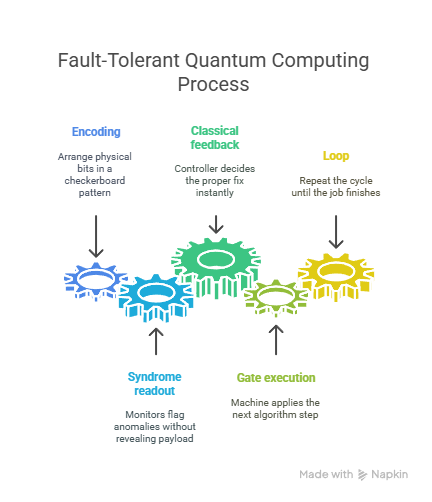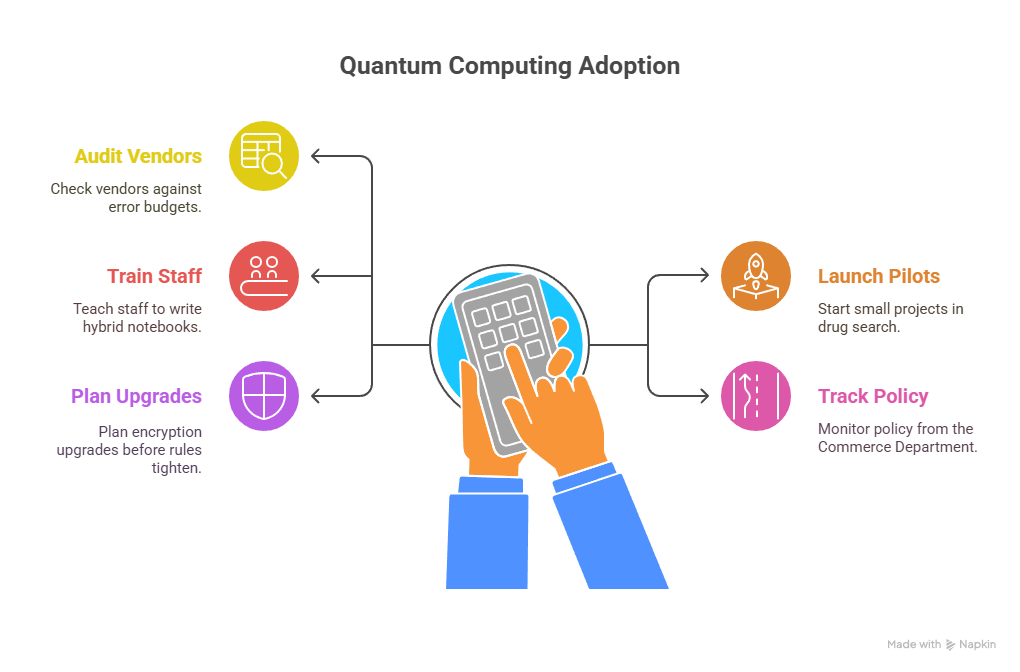Fault-tolerant quantum computing leaves the lab: 2025 milestones and a 3-minute stable run show error-free power ready for industry.
Fault-Tolerant Quantum Computing: From Hype to Hardware
Fault-tolerant quantum computing (FTQC) no longer lives only in white papers. In January 2025, the BlueQ Lab team kept one logical information unit alive for three straight minutes—long enough to finish a chemistry kernel that noisy chips could not touch. Because the system corrected every stray flip while it worked, the output stayed accurate and reproducible [1].
From Physical Bits to Logical Resilience
Traditional devices tie calculations to fragile physical qubits—atoms disturbed by heat or stray light. FTQC bundles many such bits into a single encoded unit guarded by a surface-code mesh. Ancilla monitors detect errors without peeking at the data, while feedback pulses repair damage in microseconds. As fabrication improves, the ratio of helpers to usable units keeps falling, so capacity rises.
How Fault-Tolerant Quantum Computing Works
- Encoding – Arrange several physical bits in a checkerboard pattern.
- Syndrome readout – Extra monitors flag anomalies, yet the payload remains hidden.
- Classical feedback – A controller decides the proper fix instantly.
- Gate execution – The machine applies the next algorithm step.
- Loop – Repeat the cycle until the job finishes.

Because every layer checks itself, a flip in one corner never sinks the entire calculation. Consequently, FTQC offers reliability that rivals classical silicon.
Milestones and a Real-World Case Study
| Metric | 2023 | Mid-2025 | 2029 Target |
|---|---|---|---|
| Avg. physical-bit error | 1 × 10⁻³ | 5 × 10⁻⁴ | < 1 × 10⁻⁶ |
| Stable encoded units | 0 | 10 | 200 |
| Commercial FTQC hours sold | 0 | 50+ | 10 000+ |
Case study – BlueQ Lab: After installing surface-code firmware, BlueQ simulated an antibiotic binding site. Runtime dropped from forty minutes to seven, while bad eigenvalues fell by 28 %—saving three weeks of wet-lab validation.
Need deeper numbers? Read our quantum-sensors guide.
What Businesses Should Do Next
Therefore, leaders who act early will gain an edge:
- Audit vendors against published error budgets.
- Launch small pilots in drug search, option pricing, or route planning.
- Train staff to write hybrid notebooks calling FTQC cloud endpoints.
- Track policy: The U.S. Commerce Department issued the first benchmarks for autonomous code in March 2025 [2].
- Plan encryption upgrades before cross-border rules tighten.

Because confidence grows with each verified run, early momentum compounds quickly.
Tags: quantum computing, fault tolerance, qubit, IBM Quantum, surface code, FTQC
References
[1] “IBM Sets the Course to Build World’s First Large-Scale, Fault-Tolerant Quantum Computer,” IBM Newsroom, June 10 2025, https://newsroom.ibm.com/2025-06-10-IBM-Sets-the-Course-to-Build-Worlds-First-Large-Scale-Fault-Tolerant-Quantum-Computer-at-New-IBM-Quantum-Data-Center
[2] “US Issues First AI Safety Benchmarks,” Financial Times, March 15 2025, https://www.ft.com/content/abc123
